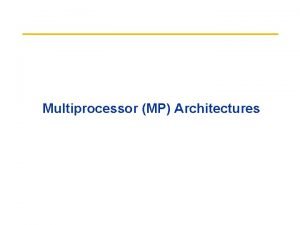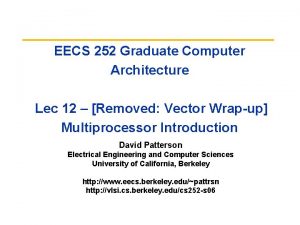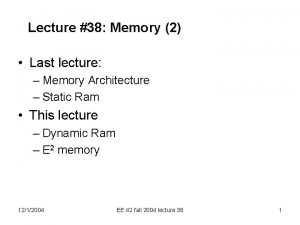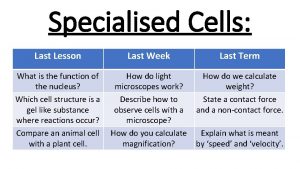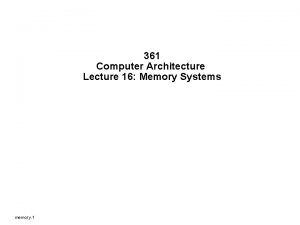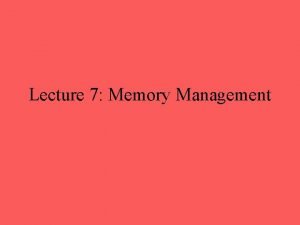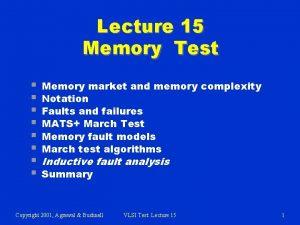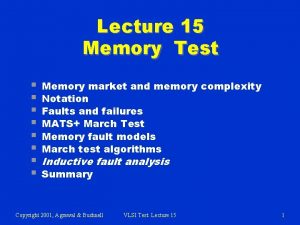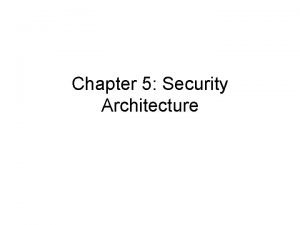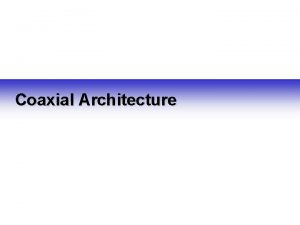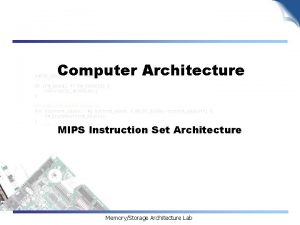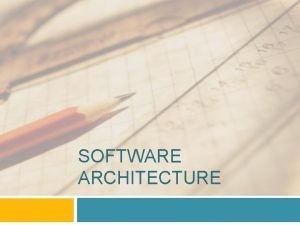Lecture 38 Memory 2 Last lecture Memory Architecture





















- Slides: 21

Lecture #38: Memory (2) • Last lecture: – Memory Architecture – Static Ram • This lecture – Dynamic Ram – E 2 memory 12/1/2004 EE 42 fall 2004 lecture 38 1

DRAM Operations • Write – Charge bitline HIGH or LOW and set wordline HIGH • Read – Bit line is precharged to a voltage halfway between HIGH and LOW, and then the word line is set HIGH. – Depending on the charge in the cap, the precharged bitline is pulled slightly higher or lower. – Sense Amp Detects change • Word Line C . Bit Line. . The signal is decreased by the ratio of the storage capacitance to the bitline capacitance – Increase density => increase parasitic capacitance – As geometries shrink, still need large bit capacitance 12/1/2004 EE 42 fall 2004 lecture 38 Sense Amp 2

DRAM logical organization Column Decoder … Sense Amps & I/O 11 D Select Memory Array … Row decoder A 0…A 10 Control logic Q Write enable 12/1/2004 EE 42 fall 2004 lecture 38 3

DRAM sense amp +V Both precharged to ½ V Bit line 12/1/2004 Data out EE 42 fall 2004 lecture 38 4

DRAM sense amplifier • The reason that DRAM is slow, is that a very small charge is captured on the capacitor, and the small voltage change on the line must be sensed. V Precharge→ 12/1/2004 Charge dumped to bit line Sense amp decides 0 or 1 EE 42 fall 2004 lecture 38 time 5

DRAM/SRAM tradeoffs • By it’s nature, DRAM isn’t built for speed – Response time dependent on capacitive circuit properties which get worse as density increases • DRAM process isn’t easy to integrate into CMOS process – DRAM is off chip – Connectors, wires, etc introduce slowness – IRAM efforts looking to integrating the two • Memory Architectures are designed to minimize impact of DRAM latency – Use dram for high density, store data which is used often in smaller, higher speed SRAM cache. 12/1/2004 EE 42 fall 2004 lecture 38 6

Nonvolatile memory • One disadvantage of both SRAM and DRAM is that if power is removed, the contents is lost. • One solution is to use SRAM designed to use very little current, and then to maintain power with a battery • Another solution is to use a memory type which physically alters the cell, such as EE memory 12/1/2004 EE 42 fall 2004 lecture 38 7

Trapped charge • Most current nonvolatile memories use a modified MOSFET with a floating gate • The floating gate can be charged or discharged by electrons moving through the oxide. • In the oldest technology, the EPROM, the floating gate is charged by hot electrons tunneling through a thin oxide, but can only be discharged by ultraviolet light exposure to the whole chip 12/1/2004 EE 42 fall 2004 lecture 38 8

UV Erase PROM Control Gate Floating Gate Si. O 2 n+ n+ Thin Oxide Source p-Substrate Drain

UV EPROM UV Light Vgg Vss Vdd --------- n+ Hot electrons Program ++++++ n+ n+ n+ Erase

Electrical EPROM Control Gate Storage Gate n+ n+

EEProm • In an EEPROM, (electrically erasable) the electrons can be tunneled back off the floating gate by applying a high voltage between the control gate and the source 12/1/2004 EE 42 fall 2004 lecture 38 12

Programming/erasing • The floating gate programmed by running a current of electrons from the source to the drain, then placing a large voltage on the control gate, a strong enough electric field to let them go through the oxide to the floating gate, a process called hot-electron injection. • To erase a flash cell, a large voltage differential is placed between the control gate and source, which pulls the electrons off the floating gate through Fowler-Nordheim tunneling, a quantum mechanical tunneling process. 12/1/2004 EE 42 fall 2004 lecture 38 13

EEPROM Vss Vdd ++++eee +++ eee -Hot - - electrons ------- n+ n+

Flash • Flash memory can be erased and reprogrammed in units of memory called blocks. It is a form of EERAM, which, unlike flash memory, is erased and rewritten at the byte level. • Erasing and rewriting as a block means faster writing times for large blocks of data. • Flash memory gets its name because the microchip is organized so that a section of memory cells are erased in a single action or "flash. " • The erasure is caused by Fowler-Nordheim tunneling in which electrons go through a thin oxide to remove an electronic charge from the floating gate. 12/1/2004 EE 42 fall 2004 lecture 38 15

Memory Comparison grid Memory type Read speed Write speed Volatility density power rewrite SRAM +++ - - ++ DRAM + + -- ++ EPROM + - EEPROM + - Flash + - ++ + + - + + + +

Flash Memory Comparison • FLASH cells can be roughly made two or three times smaller than the EEPROM • Flash memory allows faster and more frequent programming than EPROM • Flash memory provides better data reliability than battery-backed SRAM • Flash memory fits in applications that might otherwise have used ROM (EEPROM), batterybacked RAM, or magnetic mass storage

Advanced memory technologies • Ferroelectric Random Access Memory (FRAMs) • Magnetoresistive Random Access Memories (MRAMs) • Experimental Memories – Quantum-Mechanical Switch Memories – Single Electron Memory • Tunneling Magnetic Junction RAM (TMJ-RAM): – Speed of SRAM, density of DRAM, non-volatile (no refresh) – “Spintronics” electron spin effects transport – Same technology used in the read heads of high-density disk-drives: Giant magneto-resistive effect

FRAM 12/1/2004 EE 42 fall 2004 lecture 38 19

Ferroelectric material 12/1/2004 EE 42 fall 2004 lecture 38 20

Tunneling Magnetic Junction 12/1/2004 EE 42 fall 2004 lecture 38 21
 01:640:244 lecture notes - lecture 15: plat, idah, farad
01:640:244 lecture notes - lecture 15: plat, idah, farad Randy pausch the last lecture summary
Randy pausch the last lecture summary Shape memory alloys lecture notes
Shape memory alloys lecture notes Architecture lecture notes
Architecture lecture notes Microarchitecture vs isa
Microarchitecture vs isa Rocky slowly got up from the mat
Rocky slowly got up from the mat Explicit and implicit memory
Explicit and implicit memory Long term memory vs short term memory
Long term memory vs short term memory Internal memory and external memory
Internal memory and external memory Primary memory and secondary memory
Primary memory and secondary memory Logical memory vs physical memory
Logical memory vs physical memory Which memory is the actual working memory?
Which memory is the actual working memory? Virtual memory and cache memory
Virtual memory and cache memory Virtual memory in memory hierarchy consists of
Virtual memory in memory hierarchy consists of Eidetic memory vs iconic memory
Eidetic memory vs iconic memory Shared memory vs distributed memory
Shared memory vs distributed memory In-memory database architecture
In-memory database architecture Share a single centralized memory
Share a single centralized memory Memory system design
Memory system design Explain virtual memory in computer architecture
Explain virtual memory in computer architecture Symmetric shared memory architecture
Symmetric shared memory architecture Memory hierarchy in computer architecture
Memory hierarchy in computer architecture

















